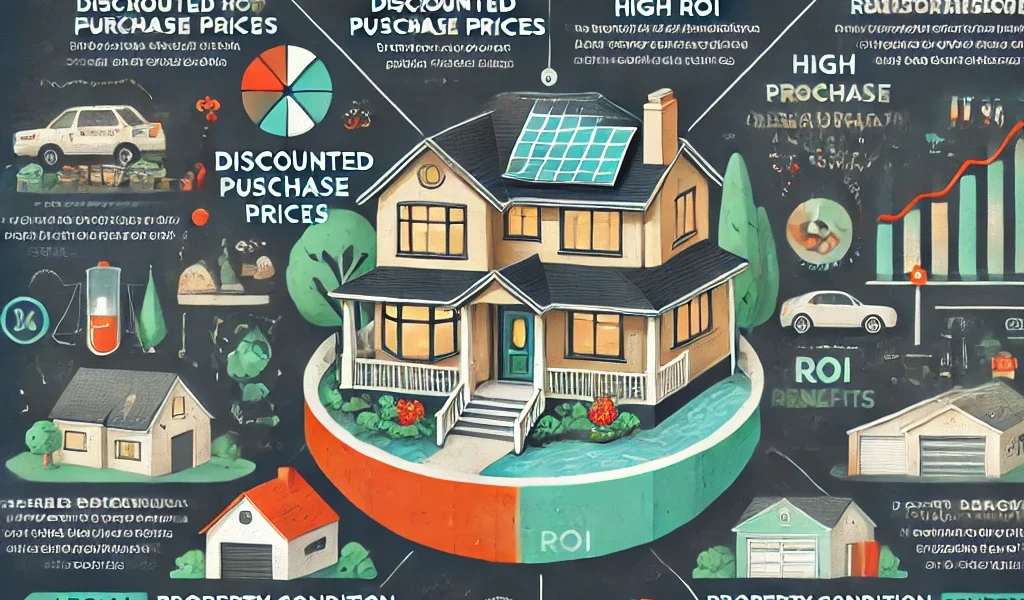Investing in foreclosed properties can be a lucrative opportunity for real estate investors looking to buy properties at a lower cost and maximize returns. However, it also comes with significant risks that must be carefully evaluated. In this guide, we’ll explore the pros and cons of investing in foreclosures, the steps to acquire these properties, and key strategies to mitigate risks while maximizing rewards.
1. Understanding Foreclosed Properties
Foreclosed properties are homes or commercial buildings that have been repossessed by a lender due to the owner’s failure to make mortgage payments. These properties are then sold through auctions, bank sales, or government programs to recover the unpaid loan amount.
2. Types of Foreclosures
Before investing, it’s important to understand the different types of foreclosure sales:
A. Pre-Foreclosure
- Occurs when a homeowner is behind on mortgage payments but has not yet been evicted.
- Investors can negotiate directly with the owner to buy the property before it goes to auction.
- This method allows for a potential discount and smoother transactions.
B. Auction Sales
- Properties are sold at public auctions to the highest bidder.
- Requires cash payment in full, often with little time for due diligence.
- Riskier but offers opportunities for below-market deals.
C. Bank-Owned (REO) Properties
- Real Estate Owned (REO) properties are taken back by banks after an unsuccessful auction.
- Generally, banks clear liens and offer financing options.
- Less risky but may be more competitive and priced higher than auction sales.
D. Government-Owned Foreclosures
- Properties owned by HUD, Fannie Mae, or Freddie Mac due to mortgage default.
- May come with special financing options and incentives.
3. Rewards of Investing in Foreclosed Properties
A. Discounted Purchase Prices
- Foreclosures often sell below market value, creating opportunities for instant equity and higher profit margins.
B. High ROI Potential
- Investors can renovate and resell at higher prices (flipping) or rent out properties for steady income.
C. Diverse Investment Strategies
- Foreclosures can be used for various investment approaches, including rental properties, fix-and-flip projects, and long-term holdings.
D. Motivated Sellers
- In pre-foreclosures, distressed homeowners are often willing to negotiate favorable deals.
4. Risks of Investing in Foreclosed Properties
A. Property Condition Issues
- Many foreclosed homes are neglected or damaged, requiring significant repairs.
- Some properties may have hidden structural problems, mold, or code violations.
B. Title and Legal Issues
- Liens, unpaid taxes, and ownership disputes can complicate transactions.
- Always conduct a title search before purchasing a foreclosed property.
C. High Competition
- Popular foreclosure markets attract institutional investors, making deals harder to secure.
- Investors need quick decision-making and strong financing options.
D. Limited Inspection Opportunities
- Auctioned properties are often sold “as-is” with no prior inspections.
- Investors must assess risks based on external evaluations and market research.
5. Steps to Successfully Invest in Foreclosed Properties
Step 1: Research the Market
- Identify areas with high foreclosure rates and strong real estate demand.
- Use online foreclosure listings, county records, and bank websites to track available properties.
Step 2: Secure Financing
- Cash purchases are common, but investors can also use hard money loans or renovation financing.
- Getting pre-approved for loans can make the buying process smoother.
Step 3: Conduct Due Diligence
- Verify property title history, outstanding debts, and ownership records.
- Estimate renovation costs and potential resale value.
- If possible, inspect the property before purchasing.
Step 4: Participate in Auctions or Bank Sales
- Set a maximum bid limit and avoid emotional overspending.
- Understand auction terms, including deposit requirements and closing deadlines.
Step 5: Renovate and Add Value
- Focus on cost-effective upgrades that maximize returns.
- Ensure compliance with local housing codes and regulations.
Step 6: Choose an Exit Strategy
- Decide whether to flip, rent, or hold the property based on market conditions.
- Evaluate long-term profitability and cash flow potential.
6. Legal Considerations to Avoid Issues
- Work with real estate attorneys to navigate complex transactions.
- Ensure compliance with local laws regarding foreclosure purchases.
- Always document agreements clearly to prevent disputes.
7. Final Thoughts
Investing in foreclosed properties can be highly rewarding, but it requires careful planning, research, and risk management. By understanding the foreclosure process, conducting thorough due diligence, and adopting the right investment strategies, you can minimize risks and maximize profits.
Whether you’re a beginner or an experienced investor, foreclosures can provide lucrative opportunities when approached wisely. Be patient, stay informed, and make data-driven decisions to succeed in this competitive market.




